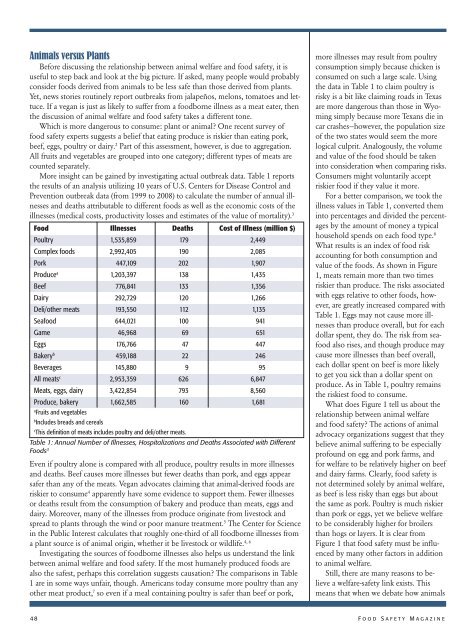Food Safety Magazine, February/March 2013
Food Safety Magazine, February/March 2013
Food Safety Magazine, February/March 2013
You also want an ePaper? Increase the reach of your titles
YUMPU automatically turns print PDFs into web optimized ePapers that Google loves.
Animals versus PlantsBefore discussing the relationship between animal welfare and food safety, it isuseful to step back and look at the big picture. If asked, many people would probablyconsider foods derived from animals to be less safe than those derived from plants.Yet, news stories routinely report outbreaks from jalapeños, melons, tomatoes and lettuce.If a vegan is just as likely to suffer from a foodborne illness as a meat eater, thenthe discussion of animal welfare and food safety takes a different tone.Which is more dangerous to consume: plant or animal? One recent survey offood safety experts suggests a belief that eating produce is riskier than eating pork,beef, eggs, poultry or dairy. 2 Part of this assessment, however, is due to aggregation.All fruits and vegetables are grouped into one category; different types of meats arecounted separately.More insight can be gained by investigating actual outbreak data. Table 1 reportsthe results of an analysis utilizing 10 years of U.S. Centers for Disease Control andPrevention outbreak data (from 1999 to 2008) to calculate the number of annual illnessesand deaths attributable to different foods as well as the economic costs of theillnesses (medical costs, productivity losses and estimates of the value of mortality). 3<strong>Food</strong> Illnesses Deaths Cost of Illness (million $)Poultry 1,535,859 179 2,449Complex foods 2,992,405 190 2,085Pork 447,109 202 1,907Produce a 1,203,397 138 1,435Beef 776,841 133 1,356Dairy 292,729 120 1,266Deli/other meats 193,550 112 1,135Seafood 644,021 100 941Game 46,968 69 651Eggs 176,766 47 447Bakery b 459,188 22 246Beverages 145,880 9 95All meats c 2,953,359 626 6,847Meats, eggs, dairy 3,422,854 793 8,560Produce, bakery 1,662,585 160 1,681aFruits and vegetablesbIncludes breads and cerealscThis definition of meats includes poultry and deli/other meats.Table 1: Annual Number of Illnesses, Hospitalizations and Deaths Associated with Different<strong>Food</strong>s 3Even if poultry alone is compared with all produce, poultry results in more illnessesand deaths. Beef causes more illnesses but fewer deaths than pork, and eggs appearsafer than any of the meats. Vegan advocates claiming that animal-derived foods areriskier to consume 4 apparently have some evidence to support them. Fewer illnessesor deaths result from the consumption of bakery and produce than meats, eggs anddairy. Moreover, many of the illnesses from produce originate from livestock andspread to plants through the wind or poor manure treatment. 5 The Center for Sciencein the Public Interest calculates that roughly one-third of all foodborne illnesses froma plant source is of animal origin, whether it be livestock or wildlife. 4, 6Investigating the sources of foodborne illnesses also helps us understand the linkbetween animal welfare and food safety. If the most humanely produced foods arealso the safest, perhaps this correlation suggests causation? The comparisons in Table1 are in some ways unfair, though. Americans today consume more poultry than anyother meat product, 7 so even if a meal containing poultry is safer than beef or pork,more illnesses may result from poultryconsumption simply because chicken isconsumed on such a large scale. Usingthe data in Table 1 to claim poultry isrisky is a bit like claiming roads in Texasare more dangerous than those in Wyomingsimply because more Texans die incar crashes—however, the population sizeof the two states would seem the morelogical culprit. Analogously, the volumeand value of the food should be takeninto consideration when comparing risks.Consumers might voluntarily acceptriskier food if they value it more.For a better comparison, we took theillness values in Table 1, converted theminto percentages and divided the percentagesby the amount of money a typicalhousehold spends on each food type. 8What results is an index of food riskaccounting for both consumption andvalue of the foods. As shown in Figure1, meats remain more than two timesriskier than produce. The risks associatedwith eggs relative to other foods, however,are greatly increased compared withTable 1. Eggs may not cause more illnessesthan produce overall, but for eachdollar spent, they do. The risk from seafoodalso rises, and though produce maycause more illnesses than beef overall,each dollar spent on beef is more likelyto get you sick than a dollar spent onproduce. As in Table 1, poultry remainsthe riskiest food to consume.What does Figure 1 tell us about therelationship between animal welfareand food safety? The actions of animaladvocacy organizations suggest that theybelieve animal suffering to be especiallyprofound on egg and pork farms, andfor welfare to be relatively higher on beefand dairy farms. Clearly, food safety isnot determined solely by animal welfare,as beef is less risky than eggs but aboutthe same as pork. Poultry is much riskierthan pork or eggs, yet we believe welfareto be considerably higher for broilersthan hogs or layers. It is clear fromFigure 1 that food safety must be influencedby many other factors in additionto animal welfare.Still, there are many reasons to believea welfare-safety link exists. Thismeans that when we debate how animals48 F o o d S a f e t y M a g a z i n e






![Otomatik indirilmez ise tıklayınız [Download]](https://img.yumpu.com/44170525/1/190x190/otomatik-indirilmez-ise-taklayanaz-download.jpg?quality=85)









